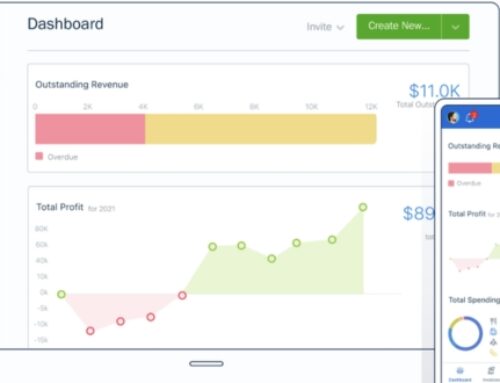Introduction
FreshBooks is a cloud-based accounting software designed to help small businesses and freelancers manage their finances efficiently. Launched in 2003, FreshBooks has evolved into a comprehensive platform that offers a range of features, including invoicing, expense tracking, time tracking, and reporting. With its user-friendly interface and powerful tools, FreshBooks has become a popular choice for individuals and businesses seeking a streamlined and effective way to handle their accounting needs.
Brief Overview of FreshBooks

FreshBooks is designed with simplicity in mind, making it accessible to users with varying levels of financial expertise. One of its key features is online invoicing, allowing users to create and send professional-looking invoices quickly. The platform also enables users to track their expenses, manage their projects, and accept online payments. With time tracking capabilities, FreshBooks provides a holistic approach to managing the financial aspects of a business.
One notable aspect of FreshBooks is its focus on automating repetitive tasks. From automating invoice reminders to organizing expenses, FreshBooks helps users save time and reduce the risk of manual errors. Additionally, the software offers real-time financial insights through its reporting tools, providing users with a clear understanding of their business’s financial health.
Importance of Profit and Loss (P&L) Analysis in Business
Profit and Loss (P&L) analysis is a crucial component of financial management for any business. Also known as the income statement, the P&L statement summarizes a company’s revenues, costs, and expenses during a specific period. This financial statement provides a comprehensive view of a business’s ability to generate profit by increasing revenue and managing costs effectively.
One of the primary reasons P&L analysis is essential is that it helps businesses assess their financial performance over time. By comparing P&L statements from different periods, businesses can identify trends, understand their revenue and expense patterns, and make informed decisions to improve profitability.
Furthermore, P&L analysis assists businesses in setting realistic financial goals and objectives. The insights gained from analyzing revenue sources and cost structures enable companies to make strategic decisions that align with their long-term financial objectives. It helps in identifying areas where cost-cutting measures can be applied or opportunities for revenue growth can be capitalized upon.
In addition to internal management, P&L statements are crucial for external stakeholders, such as investors, creditors, and potential business partners. These stakeholders rely on P&L analysis to evaluate a company’s financial health and its ability to generate returns on investment. A healthy and well-managed P&L statement can instill confidence in investors and attract potential partners, contributing to the overall success and growth of the business.
FreshBooks offers a comprehensive and user-friendly solution for small businesses and freelancers to manage their finances effectively. With features like online invoicing, expense tracking, and reporting, FreshBooks simplifies accounting tasks, saving time and reducing the likelihood of errors. Simultaneously, the importance of Profit and Loss (P&L) analysis in business cannot be overstated. It serves as a vital tool for assessing financial performance, setting strategic goals, and building confidence among external stakeholders. Together, FreshBooks and P&L analysis contribute to a holistic financial management approach, empowering businesses to thrive in a competitive landscape.
Understanding FreshBooks:

- Cloud-Based Accounting Software:
FreshBooks is a cloud-based accounting software designed primarily for small businesses and freelancers. Being cloud-based means that users can access their financial data from anywhere with an internet connection.
- Invoicing and Billing:
One of the core features is its invoicing and billing capabilities. Users can easily create and customize professional-looking invoices. This helps in streamlining the billing process and ensures that businesses get paid on time.
- Expense Tracking:
FreshBooks simplifies expense tracking by allowing users to capture expenses on the go. This feature is particularly beneficial for small business owners who often need to manage expenses while on the move.
- Time Tracking:
For service-based businesses or freelancers, time tracking is crucial. FreshBooks provides tools for tracking billable hours and seamlessly integrates this information into the invoicing process.
- Financial Reporting:
The software offers a variety of financial reports that provide insights into the financial health of the business. Users can generate reports related to profit and loss, expenses, tax summaries, and more.
- Multi-Currency Support:
For businesses operating internationally or dealing with clients in different currencies, FreshBooks supports multi-currency transactions, making it easier to manage global financial activities.
- Integration with Third-Party Apps:
FreshBooks integrates with various third-party apps, such as payment gateways, CRM systems, and project management tools, to enhance overall business efficiency.
Significance of Accurate Financial Tracking for Small Businesses:
- Decision-Making:
Accurate financial tracking provides small businesses with the data needed for informed decision-making. It allows owners to analyze financial trends, identify profitable areas, and make strategic choices for the growth of the business.
- Compliance and Taxation:
Proper financial tracking ensures compliance with tax regulations. It simplifies the process of preparing financial statements and tax returns, reducing the risk of errors and penalties.
- Cash Flow Management:
Small businesses often face cash flow challenges. Accurate financial tracking helps in monitoring cash flow, enabling businesses to manage expenses, plan for future investments, and avoid financial crises.
- Client Relationships:
For service-based businesses, transparent and accurate financial transactions contribute to building trust with clients. Professional invoicing and clear financial records enhance the credibility of the business.
- Scaling Operations:
As a small business grows, the ability to scale operations becomes crucial. Accurate financial tracking provides insights into areas that need improvement, helping businesses scale efficiently without compromising financial stability.
- Investor and Lender Confidence:
For businesses seeking external funding or loans, accurate financial records instill confidence in investors and lenders. It demonstrates the business’s financial stability and the ability to repay loans or generate returns on investment.
Importance of P&L Analysis in Business Management

Profit and Loss (P&L) analysis is a critical component of business management that involves examining and interpreting a company’s financial performance over a specific period. This analysis is typically presented in the form of a Profit and Loss statement, also known as an income statement.
Decision-making based on financial data:
P&L analysis provides a comprehensive overview of a company’s revenues, costs, and expenses during a specific time frame. This data is crucial for decision-making processes within the organization.
Managers can use P&L analysis to assess the profitability of different products, services, or business segments. This information is instrumental in making strategic decisions such as product pricing, resource allocation, and market expansion.
Identifying revenue sources and cost centers:
P&L analysis helps in identifying the primary sources of revenue for a business. This insight allows managers to focus on and strengthen the most profitable aspects of the company.
On the flip side, it also helps in pinpointing cost centers or areas where expenses are higher than anticipated. Understanding these cost centers enables management to implement cost-cutting measures or reallocate resources to improve overall efficiency.
Performance evaluation:
The P&L statement provides a snapshot of a company’s financial health over a specific period. By comparing P&L statements over different periods, businesses can evaluate their financial performance and track trends.
This evaluation aids in identifying areas of improvement and helps management implement strategies to enhance overall profitability. It also provides insights into the effectiveness of past business decisions and allows for adjustments to future strategies.
Investor and stakeholder communication:
P&L statements are crucial for communicating the financial performance of a business to investors, stakeholders, and creditors. These statements provide a transparent view of the company’s ability to generate profit and manage costs.
Investors use P&L analysis to assess the financial health and profitability of a company before making investment decisions. Effective communication through accurate P&L statements helps build trust and confidence among stakeholders.
Budgeting and forecasting:
P&L analysis is essential for budgeting and forecasting purposes. It provides a historical perspective on revenues and expenses, which is valuable when creating future financial plans.
By understanding past financial performance, businesses can set realistic financial goals, allocate resources effectively, and create budgets that align with their overall strategic objectives.
The Basics of Profit and Loss Analysis
The Profit and Loss (P&L) statement is a fundamental financial document that provides a comprehensive overview of a company’s financial performance over a specific period. Also known as the Income Statement, it is a vital tool for businesses, investors, and analysts to assess the profitability and operational efficiency of a company. In this discussion, we will delve into the definition of a Profit and Loss statement and explore its key components in detail.
A Profit and Loss statement is a financial report that summarizes a company’s revenues, costs, and expenses during a specific period, usually a quarter or a year. The primary objective of a P&L statement is to provide stakeholders with insights into the profitability of a business by showcasing the difference between total revenues and total expenses. The resulting figure, known as the net income or net loss, is a critical indicator of the company’s financial health.
Key Components of a P&L Statement:
- Revenue:
The first section of a P&L statement outlines the total revenue generated by the business during the specified period. Revenue typically includes sales of goods or services, interest, royalties, and any other income streams relevant to the business.
- Cost of Goods Sold (COGS):
Directly associated with revenue, the COGS represents the direct costs incurred in producing the goods or services sold. This includes raw materials, labor, and manufacturing overhead. Subtracting COGS from revenue gives the gross profit.
- Gross Profit:
Gross profit is a key metric that reveals the profitability of a company’s core operations. It is calculated by subtracting the COGS from the total revenue. A healthy gross profit indicates that a business is effectively managing its production costs.
- Operating Expenses:
This section encompasses all non-production costs necessary for running the business. Common operating expenses include salaries, rent, utilities, marketing expenses, and administrative costs. The difference between gross profit and operating expenses yields the operating income.
- Operating Income:
Operating income reflects the profit or loss generated from a company’s core business activities, excluding taxes and interest. It provides a clear picture of the company’s operational efficiency.
- Other Income and Expenses:
This category includes any additional sources of income or expenses not directly related to the core business operations. Examples may include gains or losses from investments, interest income, or extraordinary expenses.
- Net Income (or Net Loss):
The bottom line of the P&L statement, net income (or net loss), is the final figure obtained by subtracting all expenses, including taxes and interest, from the total revenue. A positive net income indicates profitability, while a negative figure signifies a net loss.
Navigating FreshBooks for Profit and Loss Analysis
Introduction:
FreshBooks is a cloud-based accounting software that offers a user-friendly platform for small businesses and freelancers to manage their finances efficiently. One of the key features that make FreshBooks a valuable tool is its capability to generate detailed Profit and Loss (P&L) reports, providing users with insights into their financial performance. In this exploration, we will delve into the process of accessing P&L reports on FreshBooks and the various customization options available for tailoring these reports to obtain meaningful and actionable insights.
Accessing P&L Reports on FreshBooks:
Navigating through FreshBooks to access P&L reports is a straightforward process that empowers users to stay informed about their business’s financial health. To begin, users can log in to their FreshBooks account and locate the ‘Reports’ tab on the main dashboard. Under the ‘Reports’ section, users will find the ‘Profit and Loss’ option, which serves as the gateway to a comprehensive analysis of their business’s financial performance.
Upon selecting the ‘Profit and Loss’ option, users will be presented with a range of customizable parameters to define the time period for the report. FreshBooks allows users to choose from predefined time frames, such as monthly, quarterly, or annually, or set a custom date range to focus on specific periods of interest. This flexibility enables users to analyze financial data in a way that aligns with their unique business needs and goals.
Customization Options for Tailored Insights:
FreshBooks goes beyond providing standard P&L reports by offering an array of customization options that empower users to tailor their financial analysis. Within the P&L report interface, users can access customization tools to modify the report layout, categorize income and expenses, and even add or exclude specific accounts for a more granular analysis.
One notable customization feature is the ability to categorize expenses, allowing users to allocate costs to specific departments or projects. This level of detail enhances the accuracy of financial analysis, enabling businesses to identify areas of profitability or potential cost-saving measures. Moreover, users can incorporate tax-related categories, making it easier to prepare for tax filings and ensuring compliance with regulatory requirements.
FreshBooks also allows users to export P&L reports in various formats, including PDF and CSV. This functionality proves valuable for sharing financial insights with stakeholders, such as investors, business partners, or tax professionals. Additionally, the exported reports can be archived for future reference or used as part of comprehensive financial presentations.
FreshBooks stands out as a powerful accounting tool that simplifies Profit and Loss analysis for businesses of all sizes. The platform’s intuitive interface and customization options provide users with a comprehensive view of their financial performance, enabling informed decision-making. By easily accessing and tailoring P&L reports, businesses can gain valuable insights into their revenue, expenses, and overall profitability, ultimately contributing to the success and growth of their ventures.
Cost Analysis on FreshBooks
1. Tracking Expenses Efficiently:
FreshBooks is an accounting software that enables businesses to track their expenses efficiently. This involves recording all expenditures, including bills, purchases, and other costs related to the operation of the business.
The platform allows users to input expenses in real time, providing a clear and up-to-date picture of where money is being spent.
2. Categorizing and Allocating Costs Accurately:
FreshBooks facilitates the categorization of expenses into relevant groups. This is crucial for creating a comprehensive breakdown of costs, making it easier to analyze and manage spending.
Accurate allocation of costs to specific projects or departments is essential for a detailed understanding of how resources are utilized within the organization.
Net Profit and Loss Assessment
Calculating Net Profit:
Net profit is the amount left after deducting all expenses (including taxes and interest) from the total revenue. FreshBooks assists in automating this calculation by integrating income and expense tracking. The software provides a clear overview of the financial health of the business by presenting net profit figures over specific periods.
Understanding the Implications of Profit or Loss:
Analyzing the net profit or loss is crucial for business decision-making. Positive net profit indicates that the business is earning more than it is spending, while a net loss suggests the opposite. FreshBooks’ reporting features can provide insights into trends and patterns, helping businesses understand the implications of their financial performance. This understanding is vital for making informed strategic decisions.
Financial Planning and Strategy:
Armed with the data on net profit and loss, businesses can develop effective financial strategies. This includes budgeting, cost-cutting measures, and identifying areas for revenue growth. FreshBooks supports businesses in creating financial forecasts based on historical data, aiding in the development of realistic and achievable goals.
Compliance and Tax Planning:
Accurate profit and loss assessments are essential for tax compliance. FreshBooks assists in maintaining organized financial records, making it easier for businesses to fulfill their tax obligations. The platform may also provide features for tax planning, helping businesses optimize their tax positions within the legal framework.
Conclusion
In conclusion, FreshBooks stands out as a powerful accounting tool that simplifies Profit and Loss analysis for businesses of all sizes. The platform’s intuitive interface and customization options provide users with a comprehensive view of their financial performance, enabling informed decision-making. By easily accessing and tailoring P&L reports, businesses can gain valuable insights into their revenue, expenses, and overall profitability, ultimately contributing to the success and growth of their ventures.








